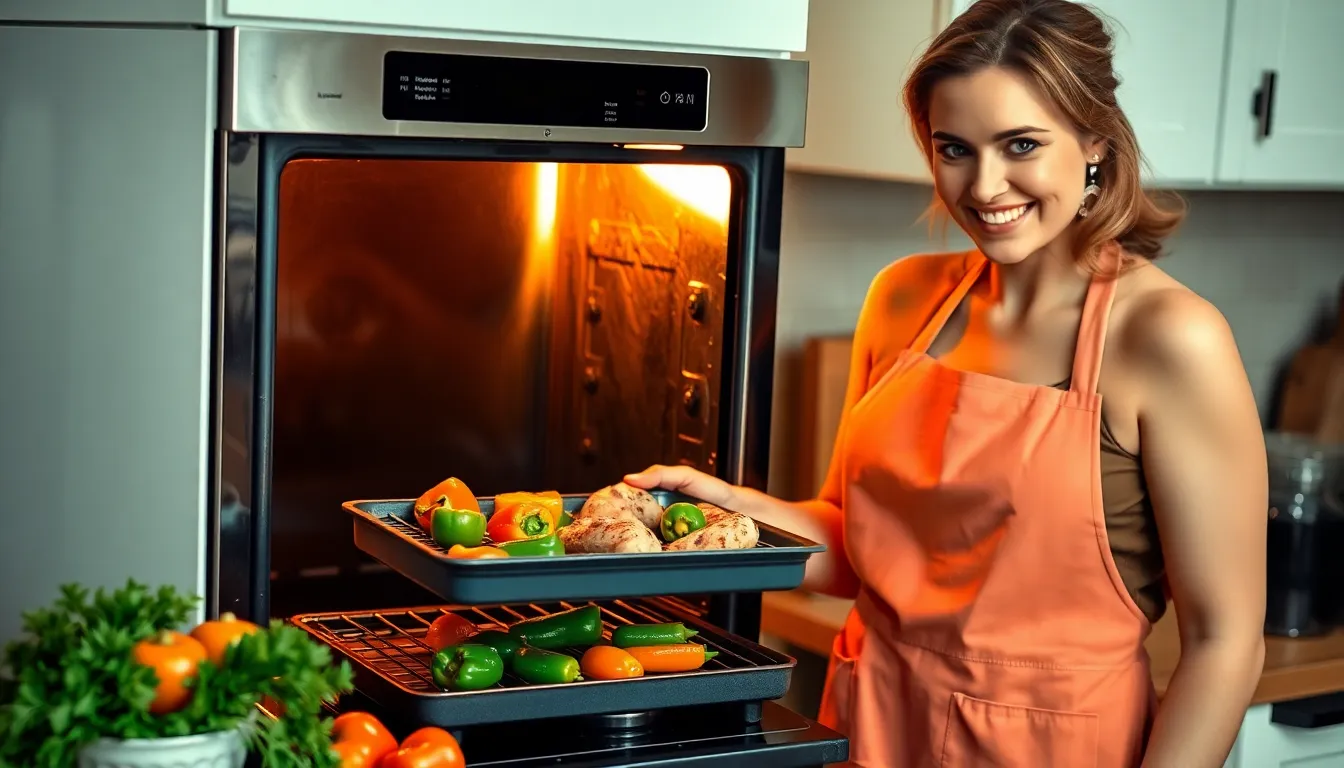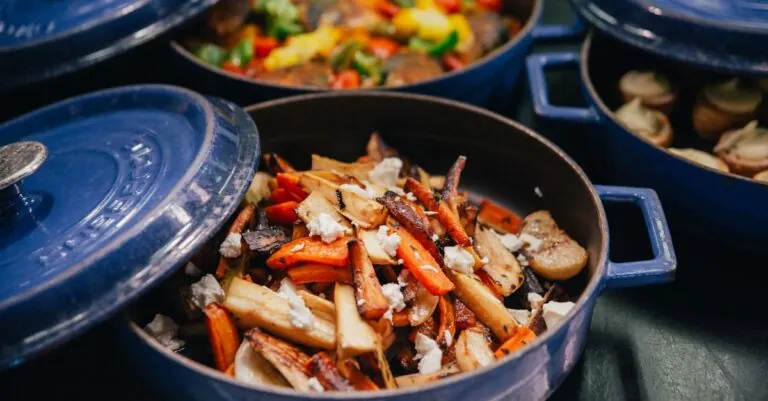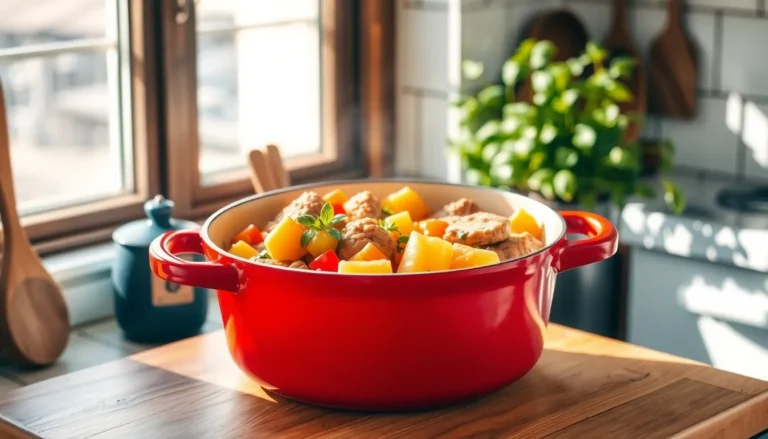When it comes to cooking, broiling might just be the superhero you never knew you needed. Imagine transforming ordinary ingredients into mouthwatering masterpieces with just the flick of a switch. Broiling is like grilling’s indoor cousin, bringing intense heat from above to create that perfect caramelized crust while keeping the inside juicy and tender.
But wait, there’s more! Broiling isn’t just for steak lovers. Whether it’s veggies, fish, or even desserts, this cooking method can elevate any dish from “meh” to “wow.” So, if your oven’s broiler has been gathering dust, it’s time to dust off those culinary skills and embrace the magic of broiling. Get ready to impress your taste buds and your dinner guests—because who doesn’t want to be the master of quick and delicious meals?
Table of Contents
ToggleWhat Is Broiling?
Broiling is a cooking method that uses high heat from above to cook food quickly. This technique utilizes the broiler element in an oven or a direct flame source. Broiling differs from baking, where heat surrounds the food, enabling faster cooking times.
The broiler’s intense heat promotes a caramelized crust, enhancing flavors and textures. As food cooks, moisture remains locked in, ensuring juiciness. Broiling works well for various foods, including meats, vegetables, and fish.
Broiling processes include preheating the broiler to get that essential intense heat. Foods placed on the upper rack benefit most from this method as they receive direct exposure to the heat source. Checking food regularly during cooking prevents burning, ensuring perfect results.
Ovens with a broiler feature typically have settings that allow for precise temperature adjustments. This convenience makes broiling an efficient cooking option for busy schedules. Techniques for using a broiler include marinating, seasoning, and using suitable cookware.
Cooking times vary depending on the item. For instance, chicken breasts can take around 10-12 minutes, while thinner cuts of fish might require only 5-7 minutes. With its ability to bring out rich flavors and crisp textures, broiling invites culinary creativity.
Benefits of Broiling

Broiling offers numerous advantages that enhance the cooking experience. Its high heat cooking method not only prepares meals quickly but also contributes to healthier eating habits and robust flavors.
Health Benefits
Broiling significantly reduces fat content in food. The high heat causes excess fats to drip away from meats and other ingredients, leading to lighter meals. Nutrient retention improves, particularly for vegetables, as quick cooking preserves vitamins and minerals. Broiling does not require additional oils or fats, which keeps dishes lighter yet satisfying. Heart-healthy cooking becomes simple, encouraging the inclusion of lean proteins and fresh produce in daily diets. Choosing broiling promotes a balanced approach to nutrition, contributing to overall well-being.
Flavor Enhancements
Flavor profiles shine through broiling. Caramelization occurs quickly under intense heat, enhancing the natural tastes of ingredients. This cooking method provides a pleasant smoky finish, making meats and vegetables more appetizing. Herbs and spices bloom when exposed to direct heat, allowing seasonings to penetrate deeper. Experimenting with various marinades or glazes can elevate standard dishes to gourmet status. While many cooking methods can deliver taste, broiling stands out for its ability to intensify flavors and create appealing textures.
Broiling Techniques
Broiling offers various techniques that enhance cooking outcomes. Understanding these methods helps maximize flavor and improve results.
Direct vs. Indirect Broiling
Direct broiling involves placing food directly under the heat source. This technique works best for thinner cuts like fish fillets and tender vegetables, emphasizing quick cooking. Indirect broiling requires positioning food away from direct heat. This approach suits thicker meats, like whole chicken or pork chops, ensuring even cooking while preventing burning. Utilizing both methods allows flexibility in meal preparation, catering to different types of ingredients.
Cooking Times and Temperatures
Cooking times and temperatures depend on food type and thickness. For example, chicken breasts typically take 10-12 minutes at a high setting, allowing for a well-seared outer layer. Fish fillets, being thinner, require only 5-7 minutes to achieve optimal results. Vegetables, such as bell peppers or asparagus, benefit from around 8-10 minutes. It’s critical to monitor food throughout the cooking process to avoid overcooking or drying out. Using a meat thermometer provides accuracy, ensuring each dish reaches the desired internal temperature safely.
Best Foods for Broiling
Broiling suits a variety of foods, making it a versatile cooking method. Chicken thighs and breasts benefit from the intense heat that caramelizes the skin while keeping the meat tender. Steaks also turn out juicy and flavorful with a nice crust, enhancing their natural richness.
Seafood stands out particularly well when broiled. Salmon fillets achieve a flaky texture with a rich taste, while shrimp cooks quickly, absorbing flavors from marinades or seasonings. These proteins grill well with herbs and spices, allowing for bold taste profiles.
Vegetables shouldn’t be overlooked. Bell peppers, asparagus, and zucchini become sweet and slightly charred under a broiler, offering a unique dimension to dishes. When broiled, the natural sugars in these vegetables enhance their flavor, providing a nutritious, delicious side.
Desserts can even find their way into the broiler. For instance, broiling peaches or pineapple with a bit of sugar caramelizes their surfaces, resulting in a delightful treat. Marshmallows on top of s’mores brown perfectly under the broiler, giving a satisfying finish.
For best results, consider cooking times based on food density. Thicker cuts, like bone-in chicken, require more time compared to thinner options such as fish. Monitor the food closely, adjusting positioning as necessary to avoid burning. Each food type brings its unique taste and texture, making broiling a culinary adventure.
Common Mistakes to Avoid
Many overlook the importance of preheating the broiler. Failing to do so leads to uneven cooking, which affects the texture and flavor of the food. Positioning food incorrectly can also cause issues; placing it too far from the heat source prevents proper caramelization.
Not monitoring cooking times often results in burnt or undercooked dishes. Every food type has a recommended cooking time, and it’s crucial to check periodically. Ignoring the need for a meat thermometer can lead to improperly cooked meats, compromising safety and taste.
Overcrowding the broiler pan is another common mistake. It restricts airflow, making it difficult to achieve that desired crispy texture. Using inadequate seasoning hampers the flavor. Herbs and spices enhance the dish’s profile; thus, applying them generously boosts overall taste.
Choosing the wrong food for broiling can be detrimental. Thicker cuts of meat, for example, may require indirect broiling to ensure they cook evenly. Forgetting to use a broiler pan can lead to a mess, as fats and juices drip and create smoke or flare-ups.
Lastly, failing to clean the broiler after use can result in lingering odors and flavor transfer to future dishes. Regular maintenance ensures optimal performance for future broiling sessions. Avoiding these common mistakes enhances the broiling experience and maximizes flavor potential.
Broiling offers a unique and effective way to elevate everyday meals. By harnessing high heat from above, it creates deliciously caramelized dishes while preserving moisture and nutrients. This technique encourages culinary creativity and healthier eating habits, making it an essential method for any home cook.
As readers embrace broiling, they’ll discover its versatility across various food types. From meats to vegetables and even desserts, the possibilities are endless. With a little practice and attention to detail, anyone can master broiling and impress family and friends with flavorful, quick meals. Rediscover the power of your oven’s broiler and transform ordinary ingredients into extraordinary dishes.







